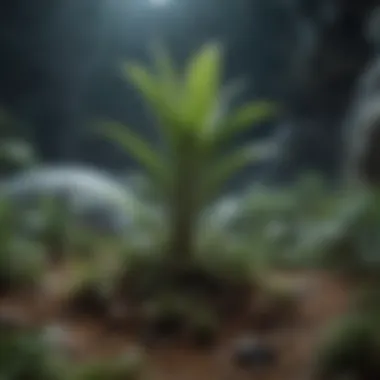Exploring Plant Life and Its Role in Space Environments


Intro
The potential for life beyond Earth prompts scientists to consider how terrestrial plant biology can inform our understanding of extraterrestrial environments. This section explores various aspects of plant adaptations and their implications for astrobiology. Understanding how plants thrive in diverse and often harsh conditions provides key insights into what life might look like on other planets.
Research Overview
Summary of Key Findings
Research in botanical science explores how plants adapt to environmental stresses. Key findings indicate that certain traits such as resilience to extreme temperatures, resistance to radiation, and specialized water retention mechanisms could be vital for survival in space environments. The insight from these adaptations is instrumental in developing theories about possible extraterrestrial plant life.
Background and Context
The study of plant biology is essential for astrobiology and planetary exploration. Considerable parallels exist between Earth’s botanical systems and what might be necessary for life on other planets, particularly Mars or icy moons like Europa. Research over the last few decades has expanded knowledge about extremophiles—organisms that can survive under extreme conditions—and this informs potential astrobiological theories.
"If we understand how plants adapt, we can better speculate about potential life forms in the universe."
Investigating the biochemical pathways plants utilize to cope with stressors can unlock new possibilities in cultivating plants in space. This is particularly relevant as human missions to Mars and other planets become more feasible.
Methodology
Experimental Design
Research often employs both field studies and controlled lab experiments to simulate extraterrestrial conditions. For example, scientists create environments that mimic Martian or lunar conditions, testing plant growth and adaptation under those specific parameters. These studies could include testing for optimal soil compositions, lighting conditions, and atmospheric pressures.
Data Collection Techniques
Data collection focuses on measuring physiological parameters such as growth rates, stress responses, and reproductive success. Techniques like spectrophotometry and imaging analysis can provide precise measurements of plant health. This quantitative data is essential for establishing solid conclusions about the viability of plants in extraterrestrial settings.
Ending
In sum, the exploration of plant biology in relation to potential extraterrestrial environments is a crucial pursuit. Plant adaptations illustrate the complexity and resilience of life, which may mirror forms we might discover in the cosmos. As the search for extraterrestrial life evolves, so too does the significance of botanical science in informing our understanding of life beyond Earth.
Prelude
The study of the relationship between botanical science and extraterrestrial environments reveals significant insights into potential life beyond Earth. This article emphasizes how understanding plant adaptability and physiology can contribute to the search for extraterrestrial life. Plants play a crucial role in Earth's ecosystems, which informs how scientists might approach the identification and cultivation of life in outer space.
The significance of plants in Earth's ecosystems
Plants are essential to Earth’s ecosystems, functioning as the foundation for food chains. They not only produce energy through photosynthesis but also contribute to the planet’s atmosphere by absorbing carbon dioxide and releasing oxygen. This process creates a sustainable environment for other living organisms. Their genetics and adaptive mechanisms showcase their ability to survive in various climates and conditions. For instance, plants in arid regions have developed strategies like reduced leaf surface area to minimize water loss. This adaptability is essential in understanding how plants could fare in extraterrestrial settings.
Moreover, plants interact with various biotic and abiotic factors, influencing biodiversity and ecological stability. Their complex relationships with other organisms, such as symbiotic fungi and pollinators, underscore the interconnectedness that exists within ecosystems. Therefore, investigating plant life on Earth sets a framework for exploring potential biological processes that could happen on other planets. This makes studying Earth’s flora integral to the broader field of astrobiology.
The quest for extraterrestrial life
The quest for extraterrestrial life stems from the desire to understand whether life exists beyond our planet. Historically, scientists have looked at extreme environments on Earth, such as deep-sea vents and acidic lakes, to find clues about potential life on Mars or other celestial bodies. These locations host unique life forms that thrive despite harsh conditions, suggesting life may not require Earth-like environments.
In recent years, missions to Mars, such as NASA's Perseverance rover, have focused on searching for signs of ancient life and conditions suitable for plant life. This is a crucial endeavor. If terrestrial plants can adapt to extreme environments, they may be instrumental in future terraforming projects. The idea of creating habitable conditions where plants can grow opens possibilities for colonization and sustainable living in space.
"The exploration of exoplanets has intensified, with many researchers focusing on finding Earth-like conditions conducive to plant and microbial life."
The integration of botanical science with astrobiology could essentially reshape our understanding of life's potential across the cosmos. By connecting the dots between existing plant biology and extraterrestrial environments, we can frame the discussion not only on how plants might survive but also flourish in an alien landscape.
Plant Adaptability


Plant adaptability is a crucial factor when exploring the potential for life in extraterrestrial environments. Plants have evolved over millions of years to survive in various climates and conditions on Earth. Understanding how these physiological and genetic adaptations work can offer insight into how life might thrive on other planets. The ability of plants to adjust to extreme environments highlights their resilience and versatility. This adaptability is not only significant for ongoing research but also essential for future missions focused on colonization beyond Earth.
Physiological mechanisms of adaptation
Plants exhibit a range of physiological mechanisms to adapt to environmental stressors. These adaptations help them modify their structure and function in response to challenges such as drought, salinity, and temperature extremes.
- Water use efficiency: Some desert plants have developed specialized structures like thick cuticles and stomata that open at night to minimize water loss.
- Photosynthesis adjustments: Certain species can alter their photosynthetic pathways to optimize energy capture under varying light conditions.
- Stress response molecules: Plants produce signaling molecules, like abscisic acid, which help regulate growth and stress responses when faced with adverse conditions.
Understanding these mechanisms can help researchers consider which plant species might survive and thrive in environments with little to no atmosphere or intense radiation, as found on some planets and moons.
Genetic adaptations in extreme environments
Genetic adaptations play a vital role in how plants withstand extreme conditions. Various studies have identified key genes involved in stress tolerance.
- Gene expression regulation: Certain genes activate or deactivate in response to environmental stressors, allowing plants to adapt its metabolism and maintain homeostasis.
- Natural selection: Over generations, plants undergo natural selection, leading to genetic variations that favor those surviving in harsh climates. This results in populations that can withstand specific extreme conditions.
- Synthetic biology applications: Insights gained from understanding plant genetics may lead to engineered crops that can adapt to extraterrestrial conditions, creating a basis for agricultural practices in space.
"The potential for plant adaptability in space exploration highlights the importance of understanding both physiological and genetic factors for future endeavors in astrobiology".
In summary, studying plant adaptability offers valuable insights not only into the resilience of life on Earth but also into the possibilities of sustaining life in space. This knowledge is fundamental when considering the establishment of human colonies on other planets.
Astrobiology and the Role of Plants
Astrobiology represents a pivotal field in understanding the possibility of life beyond Earth. Its essence lies in examining the conditions that support life, the environments where it may exist, and how life might adapt to those extraterrestrial realms. Integral to this exploration is the study of plants, which serve not only as a foundation for life on Earth but also as potential indicators of habitable conditions elsewhere in the universe. The role of plants in astrobiology cannot be overstated, as their unique biochemical processes and resilience could inform our approach to colonization and sustainability in other planetary systems.
Mars: A case study for plant life
Mars provides a rich context for studying potential plant life beyond Earth. This planet has conditions that differ significantly from our own, including a thin atmosphere and harsh temperatures. Still, Mars exhibits evidence of hydrated minerals, polar ice caps, and indications of past liquid water flows. Understanding whether plant life can thrive there raises critical questions about biological adaptation.
Research conducted by various space agencies has suggested that certain terrestrial plants might adapt to Martian conditions. For instance, experiments with Arabidopsis thaliana, a model organism in plant research, have demonstrated its ability to survive in simulated Martian environments. This kind of research helps scientists determine the specific physiological and genetic mechanisms that allow plants to thrive under extreme conditions.
"Plants are not just life forms on Earth; they may play a crucial role in future space habitats."
Additionally, Mars’ surface contains what may serve as resources for plant growth. Potentially usable water in the form of ice, along with a manageable supply of nutrients, could support plant life. Considering these elements is crucial for any future terraforming efforts aimed at transforming Mars into a more Earth-like environment.
Investigating exoplanets: The habitability index
The ongoing search for life on exoplanets has intensified the discourse surrounding the habitability index. This index relies on various parameters, such as temperature, atmospheric conditions, and the presence of water, to assess the possibility of life-supporting ecosystems outside our solar system. Plants are key in this examination.
Current research seeks to determine which factors indicate a planet's capability to sustain plant growth. For instance, exoplanets within the habitable zone of their stars, where conditions are neither too hot nor too cold, are prime candidates for further investigation. Here, plants can potentially utilize energy from sunlight, just as they do on Earth.
Recent missions, such as those by the James Webb Space Telescope, are expected to provide crucial data on atmospheric composition. By analyzing the presence of gases associated with biological processes, astrobiologists can infer the likelihood of plant life on these distant worlds.
In sum, the intersection of astrobiology and the role of plants invites a deeper exploration of life's potential beyond Earth. Both on Mars and in the study of exoplanets, understanding how plants can survive and thrive in alien environments will undoubtedly shape our endeavors towards sustainable extraterrestrial habitats.
Techniques for Plant Studies in Space
Researching plant growth in outer space reveals vital insights into how plants can adapt and thrive under unique conditions. Techniques used in space studies aim to understand plant behavior in microgravity, which can lead to advancements in botany and help in potential colonization efforts. This section elaborates on two prominent methods: growth in microgravity environments and sustainable solutions like hydroponics and aeroponics. Together, they illustrate the critical role of plant studies in supporting human endeavors on other planets.
Growth in microgravity environments
The phenomenon of microgravity affects biological processes significantly. Plants naturally orient their growth based on gravity, which influences root and shoot direction. In microgravity, this natural behavior changes, prompting scientists to study how plants respond. Research aboard the International Space Station (ISS) has shown that plants can still grow, but their mechanisms exhibit changes.
When plants are exposed to microgravity, they rely on other signals, such as light and moisture, to determine growth direction. Studies, like those from NASA's Veggie experiment on the ISS, provide evidence on how plants adapt their physiological processes. For instance, gene expression related to growth is altered, which may lead to differences in physical structure and nutrient uptake.
Significant findings include:


- Changes in root system development, affecting nutrient absorption.
- Alterations in photosynthesis efficacy, with implications for food production in space.
- Evidence of unique physical responses, such as altered cell elongation rates.
Such adaptations could be leveraged to cultivate plants in future extraterrestrial missions. Understanding these changes offers potential pathways for developing crops that can grow effectively in habitats beyond Earth.
Hydroponics and aeroponics as sustainable solutions
As we consider plant cultivation in outer space, hydroponics and aeroponics emerge as promising methods. Both techniques eliminate soil use, which is essential in environments where traditional farming methods are impractical.
Hydroponics involves growing plants in a nutrient-rich water solution. This technique offers several benefits:
- Efficient nutrient management: Nutrient delivery is direct, minimizing waste.
- Controlled environment: Variables like pH, moisture, and nutrient levels can be finely tuned for optimal growth.
Aeroponics, on the other hand, grows plants in a mist environment. Roots are suspended in air and periodically sprayed with nutrient solution. This method has several advantages:
- Reduced resource use: Less water and nutrients are required compared to traditional agriculture.
- Accelerated plant growth: The exposure to high oxygen levels enhances growth rates.
Both hydroponics and aeroponics not only provide solutions for food production in space but also contribute to a closed-loop resource system. This is critical for long-term human presence in extraterrestrial environments.
In summary, these methodologies create a foundation for sustainable practices that could support life during extended space missions, ensuring that astronauts have access to fresh food while minimizing dependency on resupply missions from Earth.
"Understanding plant growth in space is not only crucial for future colonization efforts but may also reshape agricultural practices on Earth."
The ongoing research in these areas continues to pave the way for practical applications that benefit, not only in astrobiology but also in addressing resource challenges we face on our home planet.
Terraforming and Its Implications
Terraforming represents a significant frontier in astrobiology. The thought of transforming barren planets into habitats suitable for human life is both ambitious and ethically complex. Understanding this process includes several elements: the scientific basis for creating Earth-like environments, suitable ecosystems, and the implications for native life forms.
The discussion about terraforming has gained traction in recent years, particularly as humanity looks beyond Earth for potential habitats. Inherent in terraforming projects is the need to evaluate the balance between human needs and the preservation of potential native ecosystems, which can be inextricably linked.
The process of creating Earth-like environments
Creating an Earth-like environment on another planet is not merely about adding water and air. It involves intricate systems working together to foster life. The initial step often includes assessing planetary conditions, such as atmospheric composition, temperature variations, and surface materials.
- Atmospheric Modifications: Techniques may involve greenhouse gas emissions to warm planetary surfaces and foster liquid water. This could utilize carbon dioxide and methane to create a more hospitable atmosphere.
- Water Introduction: Where liquid water is scarce, options include melting polar ice or redirecting comets and asteroids rich in ice. Water is fundamental for life as we know it, and establishing water sources will be critical.
- Soil Development: The creation of viable soil involves the introduction of nutrients and organic matter. Microbial life forms may be introduced to facilitate the breakdown of materials and establish a nutrient cycle.
- Biodiversity Initiatives: Ensuring a balanced ecosystem means introducing a variety of species that can support each other. This strategic planning will help build a resilient environment capable of sustaining life.
"The idea of creating life-sustaining conditions on barren worlds challenges us to rethink our role as stewards of existence."
Selection of suitable plant species for terraforming
Choosing the right plant species for terraforming is paramount. Plant selection impacts the success of the ecological balance and potential for sustaining life.
- Hardiness and Adaptability: Species like Svalbard Global Seed Vault species can endure extreme conditions. Identifying plants that display remarkable resilience can provide a solid foundation for terraforming efforts.
- Photosynthesis Efficiency: Plants utilize sunlight for energy. Choosing species with efficient photosynthesis mechanisms will enhance the planet’s ability to convert solar energy into usable energy.
- Soil Enrichment: Species that can fix nitrogen in the soil, such as clover or legumes, are beneficial for developing fertile land. They can help modify the soil chemistry to support other trophic levels.
- Water Retention Properties: Plants like succulents can withstand arid conditions and will be instrumental if introduced in ecosystems where moisture is limited.
- Genetic Modifications: Some researchers consider using genetically engineered species that are even more resilient or capable of thriving in less-than-ideal conditions, tailored specifically to each planetary environment.
Establishing the right flora is essential; it dictates the success of terraforming and enables human life to flourish beyond Earth. The ongoing studies into plant adaptability can provide insight into how Earth species may function in alien environments.
Ethical Considerations
The exploration of outer space and the potential for life on other planets raises significant ethical questions, especially about the role of botanical science. When considering the introduction of Earth species to alien ecosystems, scientists and ethicists must evaluate the potential consequences on both extraterrestrial environments and Earth’s ecosystem.
This ethical dimension is crucial for several reasons:
- Preventing ecological disruption: Introducing Earth plants or animals to alien worlds could lead to unforeseen ecological consequences. These species could outcompete native life forms for resources, potentially leading to extinction of native species.
- Understanding our impact: Earth has a history of species introduction leading to ecological issues, such as invasive species disrupting local ecosystems. Learning from these instances is essential for responsible exploration and colonization strategies.
- Moral considerations: There is a responsibility to consider not just the benefits of colonization but also the rights of potential native life. This introduces the question of whether humans have the right to alter other worlds.
"The ethical implications of our potential actions in space could define the legacy we leave for future generations, not just on Earth but across the universe."


The implications of introducing Earth species to alien planets
Introducing Earth species to alien planets comes with substantial risks and considerations. One significant issue is the ability of these species to adapt and thrive in environments that are vastly different from their native habitats. For instance, Tardigrades or dandelions may survive, but their impact on local ecosystems could be detrimental. Researchers must ask the following:
- How will introduced species interact with native flora and fauna?
- Will they disrupt existing ecological networks?
- Could they potentially become an invasive threat?
Regulatory frameworks must guide these undertakings. Scientists should prioritize studying native ecosystems closely before any introductions occur. Uncontrollable variables need extensive research to understand their long-term ecological impacts entirely.
Preserving native extraterrestrial ecosystems
Another critical ethical concern revolves around the preservation of any native ecosystems that might already exist on other planets. With missions targeting Mars or exoplanets, we face pressing needs to protect potential native species and their environments. Preservation can take multiple forms:
- Conducting thorough surveys: Before any mission, surveys of potential habitats should assess for any signs of existing extraterrestrial life.
- Establishing protected protocols: Strong protocols should guide exploration efforts to minimize contact with and disturbance to these ecosystems, similar to conservation efforts on Earth.
- Promoting interplanetary ethics: Developing a framework of ethics for interplanetary exploration may guide future endeavors, ensuring that any introduction of Earth species is done responsibly.
Research Developments
Understanding the research developments in plant science is crucial, particularly as it relates to extraterrestrial environments. This field not only informs us about how plants can adapt to harsh conditions, but also how this knowledge can guide future explorations and potential colonization efforts. The ongoing research efforts highlight the resilience of plant biology, revealing important insights into potential life-support systems for human habitation beyond Earth.
Current research on plants in outer space
Current research focuses on various aspects of how plants react to the unique challenges presented by space environments. NASA has conducted experiments aboard the International Space Station (ISS) to study plant growth in microgravity. These studies assess how plants germinate, grow, and respond to stressors in this unfamiliar setting. One notable project is the Veggie experiment, which aims to grow food for astronauts while gathering data on plant behavior in microgravity.
"Understanding plant responses in space may hold the key to sustaining human life on other planets."
Some findings indicate that plants can adapt their growth mechanisms when in limited gravity. For instance, Arabidopsis thaliana, a model organism, has shown variations in root and shoot growth patterns compared to those on Earth. These differences provide vital data that helps researchers optimize conditions for future plant growth in extraterrestrial habitats.
Future prospects for space botany
The future of space botany holds great promise. As space agencies and private companies focus on long-duration missions and potential colonization, enhancing our understanding of plant biology becomes essential. Future research may delve deeper into genetic modifications that could allow plants to thrive on Mars or other harsh environments. This could involve engineering crops with traits that improve resilience to radiation and extreme temperatures.
Moreover, the development of advanced systems like hydroponics and aeroponics will play a key role in space agriculture. Such methods enable efficient water and nutrient use, which is crucial for sustaining life in a closed environment. Research can also expand into the interplay between plants and microorganisms in extraterrestrial settings, enhancing soil health and promoting ecosystems.
Ending
The conclusion of this article provides a critical synthesis of the various themes discussed. The interplay between botanical science and extraterrestrial environments is not merely an academic curiosity; it holds tangible implications for humanity's future in space. Understanding how plants can adapt to and thrive in alien ecosystems enhances our search for life beyond Earth while also informing the development of sustainable practices for human colonization and exploration.
In summarizing the key findings, we reaffirm the importance of physiological and genetic adaptability in plants. These adaptations are foundational to survival in extreme conditions, whether on Earth or in extraterrestrial settings. The implications of these findings extend into various fields, including astrobiology and environmental science, providing a multifaceted approach to exploring life beyond our planet.
The exploration of potential plant life on other celestial bodies, especially Mars and exoplanets, speaks to the urgency of preparing for future human missions. The potential of plants in space colonization relies heavily on our understanding of their growth mechanisms in diverse environments. By harnessing the knowledge gained through ongoing research, we can identify the necessary biological traits that will allow plants to sustain human life in outer space.
Summary of key findings
Key findings from our exploration include:
- Plants possess remarkable adaptability features, such as special physiological processes and genetic modifications, that enable them to exist in extreme environments.
- Mars serves as a crucial case study for research on plant life. Studies highlight the challenges and opportunities of growing plants in Martian soil and atmosphere.
- The habitability index for exoplanets offers a framework for assessing potential environments where plant life might flourish.
- Innovative techniques, including hydroponics and aeroponics, show promise for enabling plant growth in microgravity and other non-Earth environments.
- Ethical considerations are paramount in discussions surrounding the introduction of Earth species to extraterrestrial habitats.
Overall, the convergence of botanical science and the research into other planets marks a significant frontier in understanding life in its various forms.
The potential of plants in space colonization
The potential of plants in space colonization cannot be understated. As we venture further into the cosmos, the need for sustainable life-support systems grows more pressing. Plants can play a vital role in this regard. They naturally perform photosynthesis, converting carbon dioxide into oxygen and producing food. This intrinsic capability can establish closed-loop ecosystems essential for long-term human habitation.
Key considerations in leveraging plants for space colonization include:
- Selection of Species: Identifying plant species that can thrive in alien conditions while meeting human nutritional and oxygen needs is paramount.
- Research Needs: Continued research into plant biology in space environments is crucial. Understanding how plants react to microgravity, radiation, and other stresses informs selection and cultivation strategies.
- Innovative Farming Techniques: Techniques like hydroponics and aeroponics will be necessary to maximize space and resources. These systems require less water and soil, which is a significant advantage in extraterrestrial settings.
"The future of humanity may depend on our ability to adapt earthly biology to foreign worlds."
Sources:







